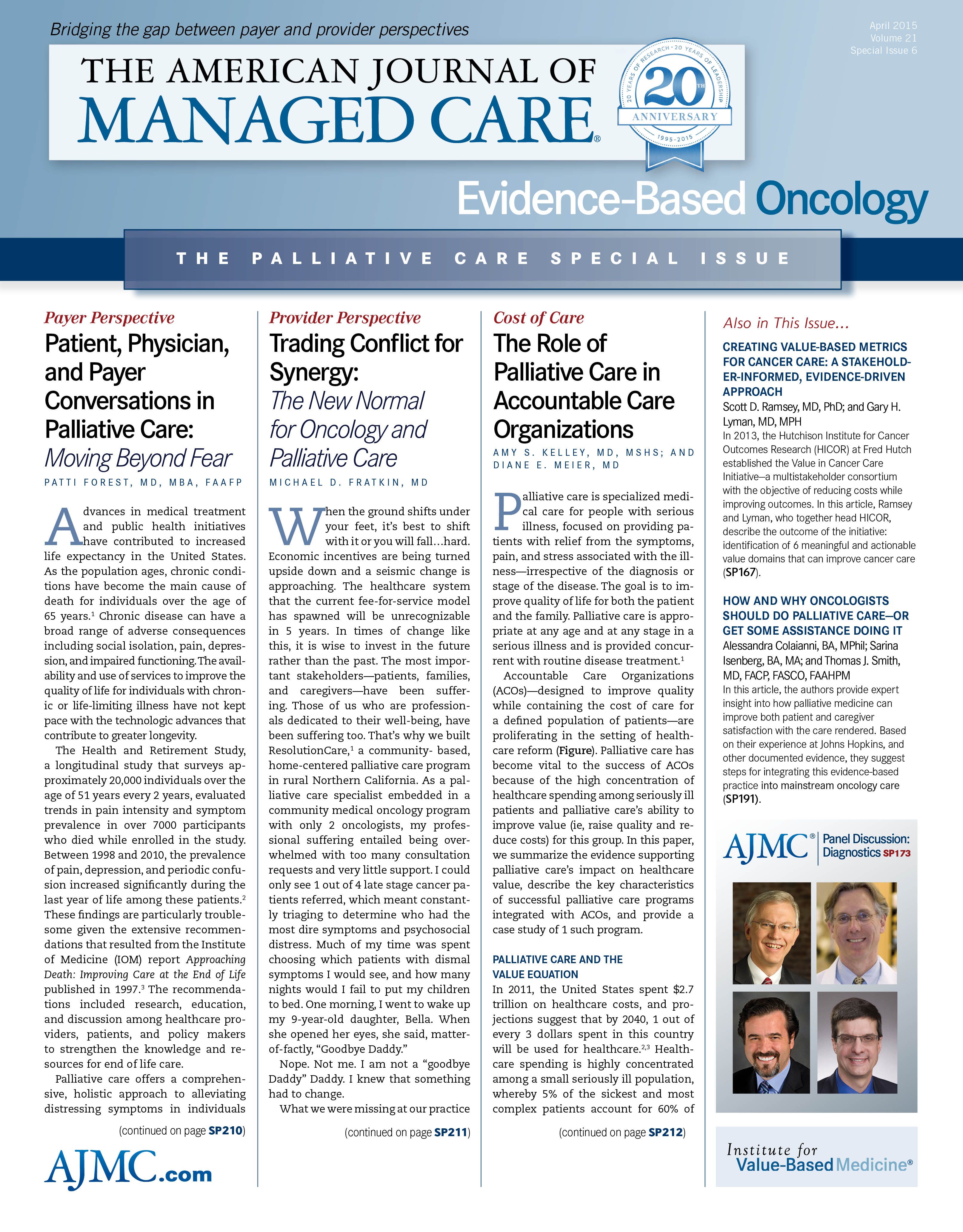Publication
Article
Evidence-Based Oncology
Patient, Physician, and Payer Conversations in Palliative Care: Moving Beyond Fear
Author(s):
Advances in medical treatment and public health initiatives have contributed to increased life expectancy in the United States. As the population ages, chronic conditions have become the main cause of death for individuals over the age of 65 years.1 Chronic disease can have a broad range of adverse consequences including social isolation, pain, depression, and impaired functioning. The availability and use of services to improve the quality of life for individuals with chronic or life-limiting illness have not kept pace with the technologic advances that contribute to greater longevity.
The Health and Retirement Study, a longitudinal study that surveys approximately 20,000 individuals over the age of 51 years every 2 years, evaluated trends in pain intensity and symptom prevalence in over 7000 participants who died while enrolled in the study. Between 1998 and 2010, the prevalence of pain, depression, and periodic confusion increased signi cantly during the last year of life among these patients.2 These ndings are particularly troublesome given the extensive recommendations that resulted from the Institute of Medicine (IOM) report Approaching Death: Improving Care at the End of Life published in 1997.3 The recommendations included research, education, and discussion among healthcare providers, patients, and policy makers to strengthen the knowledge and resources for end of life care.
Palliative care offers a comprehensive, holistic approach to alleviating distressing symptoms in individualssuffering serious illness that may be life-limiting. Signi cant progress in pro- moting palliative care has been made since the landmark IOM report. Agencies such as the National Hospice and Palliative Care Organization provide free resources to help people make decisions about preferences for treatment at the end of life. The American Board of Medical Specialties formally recognized palliative medicine as a specialty in 2008. In addition, many medical schools and residency programs incorporate palliative care in their training. The American Hospital Association published strategies in 2012 to promote performance improvement in advanced illness management. This work focuses on ways to improve quality of care, increase patient satisfaction, and reduce inef ficiencies in the treatment of patients with serious illness.4 More recently, the Coalition to Transform Advanced Care developed an Advanced Care Model that coordinates care across multiple settings to deliver a patient-centered, high-quality, integrated approach for treatment of individuals with advanced illness.5 Mainstream media has also entered the dialogue with numerous articles and editorials being published related to the quality of life and nancial bene ts of palliative care. For instance, a recent article in The Wall Street Journal cited examples of patients who were not considered at end of life who greatly bene tted from the physical and emotional support provided by palliative care programs. “Most people who need palliative care are in fact not dying, but have one or more chronic diseases which they may live with for many years,”6 said Diane Meier, MD, the director of the Center to Advance Pallia- tive Care, in the article, which followed an earlier interview of Dr Meier.7
Despite increased awareness and multiple approaches to improving access to palliative care services, there remains signi cant opportunity for further coordination across the healthcare continuum. Factors contributing to suboptimal use of palliative care services include limited access to services, misaligned payment models, and fragmented care delivery systems. In addition to these obvious barriers, another factor is anxiety on the part of patients, physicians, and payers. Patients may avoid voicing their wishes for fear that they will be denied curative treatment to improve their clinical condition. While many physicians are comfortable discussing end of life preferences, others may hesitate to initiate a discussion due to fear that patients will perceive they have abandoned hope. Payers may avoid developing programs that promote palliative care services for fear of being accused of bias toward reducing medical expenditure for ongoing treatment. These fears are not unwarranted—“ death panel” allegations that arose during the early days of the Affordable Care Act ampli ed the hesitancy to discuss end of life care among patients, providers, and payers.
In light of the controversy surrounding physician payment for end of life discussions, and in an attempt to address barriers to appropriate end of life care, IOM undertook a study to review the current state of care for persons with advanced illness who may be approaching death. The subsequent report, Dying in America, was published in late 2014 and outlined recommendations intended to encourage conversation between patients, families, providers, payers, and policy makers with the goal of high quality end of life care that is consistent with an individual’s preferences and values.8 These recommendations include payment reform and policy support, development of evidence-based quality standards, professional education and development, and public education and engagement.
Payment reform is necessary to make palliative care and advanced illness management more accessible and sustainable, and numerous pilot models and initiatives have been launched to achieve the said objective:
• The CMS Innovation Center is testing payment and service delivery models that improve quality and reduce cost of care. The Medicare Choices Model allows Medicare bene ciaries to receive palliative care services (delivered by select hospice providers) while receiving ongoing active treatment for their medical condition.9
• This year, the American Medical Association released procedure codes for payment of advance care planning services. The availability of these codes paves the way for providers to get reimbursed for discussions with patients and families around end of life and advanced illness management preferences.10
• In 2014, the Center to Advance Palliative Care published a tool kit that identi es opportunities to integrate palliative care services in payer- provider partnerships and offers examples of initiatives already implemented by leading payer organizations.11
PALLIATIVE CARE INITIATIVES ADOPTED BY BLUE CROSS BLUE SHIELD
Blue Cross Blue Shield of North Carolina developed the Blue Quality Physician Program (BQPP) to recognize and nancially reward practices that demonstrate a commitment to patient- centered care and focus on improving health outcomes and reducing cost of care. Although developed in 2009 for primary care practices, it is now offered to community-based oncology providers. Participating primary care and oncology practices must demonstrate completion of education modules in cultural competency, palliative care, and advanced illness management. In addition, oncology practices are required to provide documentation to verify that patients receive measurement of functional status at various points during treatment, development, and communication of a cancer treatment plan, along with documentation of goals of care. The number of palliative care and hospice referrals from the oncology practice is also tracked. BQPP has gathered encouraging results from this pay-for-performance program. While primary care practices in the BQPP program demonstrate improved quality over peer practices, early results from the BQPP oncology program indicate a high level of commitment to care planning and communication and offering of palliative care services. The cost of care in these practices is generally lower than health system-owned peer practices, with fewer emergency department visits and hospital admissions. Importantly, both provider and patient satisfaction are high.
Value-based reimbursement aligns payers and providers to focus on quality of care, cost of care, and enriching the patient experience. Increased transparency improves consumer awareness of costs, and helps them play a critical role in the value of care conversation. With approximately one fourth of Medicare spending occurring during the last year of life,12 the potential cost savings achieved by comprehensive advanced illness management and palliative care services is signi cant. For example, Sutter Health’s Advanced Illness Management program demonstrated a cost reduction of $5000 per patient at 90 days post enrollment,13 coupled with very high patient and caregiver satisfaction.
EBO
REFERENCES
Palliative care should not be reserved for individuals at the end of life, but should also be widely available for patients with conditions involving treatment with temporary but severe side effects. As new models become available to deliver palliative care to a broader population, the stigma for palliative care services can be reduced by focusing on relieving pain and suffering, regardless of the life expectancy of the patient. Advanced illness management may be a more acceptable term that encourages earlier dialogue between patients and physicians. Public engagement to advocate for policies to support palliative care services is an important component in aligning funding priorities. It is also important for consumers to help guide payers in development of advanced illness and palliative care programs as well as bene t designs. Together, these activities will increase transparency and decrease fear of end of life conversations among patients, providers, and payers. As we replace fear with empowerment, we will further improve the quality of care at the end of life. Patti Forest, MD, MBA, FAAFP, is senior medical director, Blue Cross Blue Shield of North Carolina.
1. The state of aging and health in America 2013. Atlanta, GA: Centers for Disease Control and Prevention, US Dept of Health and Human Services; 2013:3.
2. Singer AE, Meeker D, Teno JM, Lynn J, Lunney JR, Lorenz KA. Symptom trends in the last year of life from 1998 to 2010: a cohort study. Ann Intern Med. 2015;162(3):175-183.
3. Committee on Care at the End of Life. Approaching Death: Improving Care at the End of Life. Washington, DC: National Academies Press; 1998.
4. Advanced illness management strategies. American Hospital Association website. http://www.aha .org/content/12/aims_strategies.pdf. Published August 2012. Accessed March 10, 2015.
5. What is advanced care? Coalition to Transform Advanced Care website. http://advancedcarecoalition. org/advanced-care/. Accessed March 10, 2015.
6. Landro L. Patients turn to palliative care for relief from serious illness. The Wall Street Journal website. http://www.wsj.com/articles/patients- turn-to-palliative-care-for-relief-from-serious-ill- ness-1419288669. Published December 22, 2014. Accessed March 12, 2015.
7. Sadick B. Straight talk about palliative care: what everyone should know. http://www.wsj .com/articles/straight-talk-about-palliative- care-what-everyone-should-know-1410724839. Published September 14, 2014. Accessed March 12, 2015.
8. Committee on Approaching Death: Addressing Key End-of-Life Issues. Dying in America: Improving Quality and Honoring Individual Preferences Near the End of Life. Washington, DC: National Academies Press; 2014.
9. The Medicare Choices Model. CMS website. http://innovation.cms.gov/initiatives/Medicare- Care-Choices/. Accessed March 12, 2014.
10. New CPT codes support Medicare payment for care coordination [press release]. Chicago, IL: American Medical Association; January 22, 2013. http://www.ama-assn.org/ama/pub/ news/2013-01-22-cpt-codes-medicare-payment- care-coordination.page.
11. Improving the care of serious illness through innovative payer-provider partnerships: a pallia- tive care toolkit and resource guide. Center to Advance Palliative Care website. https://www .capc.org/payers/palliative-care-payer-provider- toolkit/. Accessed March 11, 2015.
12. Calfo S, Smith J, Zezza M. Last year of life study. http://www.cms.gov/Research-Statistics- Data-and-Systems/Research/ActuarialStudies/ downloads/Last_Year_of_Life.pdf. Accessed March 11, 2015.
13. Sutter Health’s Advanced Illness Manage- ment (AIM) ® featured in national publications [press release]. Sacramento, CA: Sutter Health; December 13, 2013. http://news.sutterhealth. org/2013/12/13/sutter-healths-advanced- illness-management-aim-featured-national-publi- cations/.







